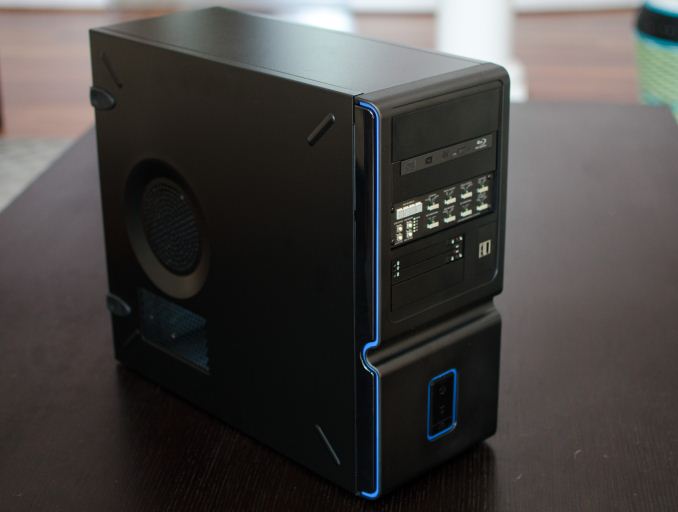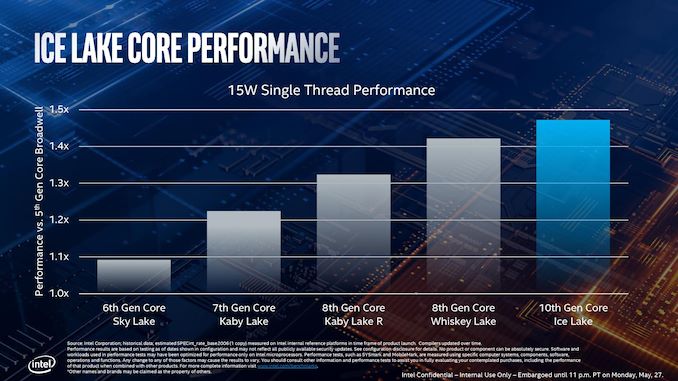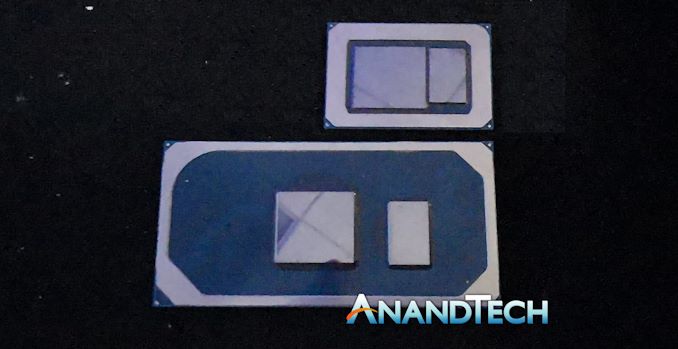The Ice Lake Benchmark Preview: Inside Intel's 10nm
by Dr. Ian Cutress on August 1, 2019 9:00 AM EST- Posted in
- CPUs
- Intel
- GPUs
- 10nm
- Core
- Ice Lake
- Cannon Lake
- Sunny Cove
- 10th Gen Core
Conclusions
First of all, I must say that Intel offering us to test a reference system in advance of a launch is a very good thing indeed. It is not something that Intel has done often in the past – in fact the last time I remember it happening was with Broadwell, when Intel sampled us one of their mobile CRB (consumer reference board) systems for the 45W chip. Before that, Intel had a small attempt allowing the press to benchmark Conroe in 2006 with canned pre-provided benchmarks, which did not go down to well. So moving into this pre-testing regime gets some immediate kudos to those who approved the testing.

Intel’s Broadwell / Crystalwell Mobile CRB
Given that the Ice Lake platform is more geared up towards ultra-premium designs, the software development system we ended up testing was certainly a reasonable expectation and direction that these parts would go in. Of course, we only had the best part of nine hours to test, and giving us the option to test both 15W and 25W modes meant we had to pick and choose what tests we thought were relevant. My most prominent feedback to Intel would be to give us two days to test next time, as it allows us to sit on our data after day one and decide what to do next. It was clear that some of the press in attendance only needed a day (or half a day), but for what we do at AT, then two days would be better.
As for Ice Lake itself, our results lean towards Ice Lake outperforming Whiskey Lake, if only by a small margin.
To preface this, I want to recall a graph that Intel showed off at Computex:
This graph shows the single thread performance of Skylake and beyond, compared to 5th Gen Broadwell hardware. Right at the very end, we see Whiskey Lake performing +42% above Broadwell, and Ice Lake performing +47% above Broadwell. A quick calculation of 1.47/1.42 means that even Intel is only predicting an absolute gain of ~3.5% for Ice Lake over current generation systems.
The reason why the difference is so small is because of IPC and frequency. Intel is touting a median IPC advantage on the new Sunny Cove cores of +18% against Skylake. That isn’t something we were able to test in the short time we had with the system, but +18% should provide a healthy bump – we actually see a number of key microarchitectural improvements bubble up through in our SPEC testing.
But at the same time, the frequency has decreased – our Whiskey Lake Huawei Matebook system was +500 MHz on the base frequency (+38%), and +700 MHz on the turbo frequency (+18%). If it were not for the vast increase in memory speed, moving from LPDDR3-2133 to LPDDR4X-3733, one might have predicted that the Core i7-1065G7 Ice Lake processor and the Core i7-8565U Whisky Lake processor would have performed equally.
The question here then becomes whether you prefer IPC or frequency. For instruction limited tasks, that answer should be IPC. For critical path limited tasks, you nominally require frequency. All this gets muddled a bit with the increased memory frequency, but with higher IPC at lower frequency, you should arguably be more power efficient as well, leading to longer battery life. At iso-performance between Ice and Whiskey, considering no other factors like price, I would choose Ice.
Intel has made a number of improvements to a chunk of the instruction set that should work well for users, however the new bigger cache design has added a bit of latency there, which ends up being a bit of give and take with cache hits and misses.
Of course, the one area where Ice Lake excels in is graphics. Moving from 24 EUs to 64 EUs, plus an increase in memory bandwidth to >50 GB/s, makes for some easy reading. It gets even better in 25W mode, for games that are CPU limited, but still don’t expect to be tackling AAA games at high resolutions. Despite Ice Lake being focused on the ultra-premium >1080p resolution market, you will still be gaming at 720p or 1080p at best here.
The other alternative is to attach a Thunderbolt 3 external graphics card. If there’s one really good add-in to Ice Lake, aside from the graphics uplift, it’s the inclusion of up to four TB3 ports as part of the CPU silicon. If and when the TB3 controllers get a lot cheaper on the device side, this should really help accelerate a high-performance standard here.
We should also talk about AVX-512 – Intel is in a position right now where including it in the chip uses a good amount of die area, and the software ecosystem hasn’t yet adopted it. By advertising speed-ups like DLBoost, the company is hoping to entice developers to work with AVX-512 in mind, and improve a number of machine learning applications for consumer processors. The other side there is what sort of consumer applications need machine learning that isn’t already done in the cloud. It’s a bit of a catch-22, but in our own testing, the AVX-512 does provide a significant speed-up. However, given Intel’s recent mantra of testing for user experience, it will be interesting to see how hammering the AVX-512 unit meshes with that mantra.
The scope of when these Ice Lake processors are coming to market, and how much, is still a question mark. Intel states that we’ll see Ice Lake in the market for the holiday season (i.e. Christmas), however we have a number of trade shows around the corner, such as IFA in September, where me might start seeing some companies start to show off their designs. We also know that Intel plans to release Comet Lake mobile processors sometime this year, on the old 14nm process and old Skylake-based microarchitecture, but at higher frequencies, so it will be interesting to see how they compete.
Final Thoughts
I’m glad to have tested Ice Lake. It’s a shame that we only had a day to test, because I could have spent a week testing that system. Increasing IPC is the best problem to solve, even if it gives similar performance due to a lower frequency, but hopefully the knock on effect here will be better battery life for users at the same performance. Once we get some systems in to test that battery life, and Project Athena’s requirement of 16+ hours comes to the front, I think we’ll see the best examples of Ice Lake shine through.













261 Comments
View All Comments
Alistair - Friday, August 2, 2019 - link
I find partisanship frustrating. You are absolutely right that we just got IPC but bad frequency from both AMD and Intel, so it is nice to see the IPC side of things, but we should be able to criticize Intel without someone brushing us off as being AMD supporters or some nonsense. The new products (these mobile chips in particular) are not very good. Still should be polite to Ian Cutress, he does do fantastic work.I guess I didn't get the memo that no 6 core ultra low voltage parts were coming. I'm very disappointed in the very tiny gains this year. I'm waiting for a good 6 core CPU at 25 watts.
0ldman79 - Friday, August 2, 2019 - link
Welcome to the Internet, where voicing an opinion on anything gets you labeled as a fanboy/X political party.Every good forum needs a block button... lol
eva02langley - Friday, August 2, 2019 - link
The difference here is that Ryzen 3000 clock higher than 2000.... little difference...Alistair - Friday, August 2, 2019 - link
Absolutely at least AMD's chips clock the same or an extra 100 mhz higher, Intel's new chips clock several hundred mhz slower, making them really poor this year. Making 6 core options more important than ever. 4 cores in this situation are really useless without a large price drop.0ldman79 - Friday, August 2, 2019 - link
This is also the efficient line of chips. Last I heard they got the efficient transistor design going but not the high performance one.They may clock higher, they may be limited by the architecture. Dunno. Could entirely be because they packed the chip too tight, the hotspots that spike the Zen 2 temps may actually be causing significant issues with 10nm. In this case the whole "transistors per sq mm" argument may become moot. Packing them in so tight they can't displace heat properly is a bad thing and may be what is happening here.
HStewart - Thursday, August 1, 2019 - link
I think you to give both Ian and Intel more credit, there is no doubt that Intel has some struggles with going to 10nm but this is first part of the recovery. The results here are extremely impressive especially that these products are low power laptop and not large desktop gaming machines.It would be interesting to compare the new Dell XPS 13 2in1 against existing dell XPS 15 2in1 in which the 15 2in1 has higher power cpu and GPU. I would say it likely with results here, the 13 2in1 has chance of beating the 15 2in1
It going to be interesting to see what 45W laptops are like and the desktop chips on Sunny Cove.
eva02langley - Friday, August 2, 2019 - link
Give Intel credit... HAHAHAHAHAHA.... they don't deserve any credit. These directors just want to have the stock rise to have a better pay check. Everything they do is biased with this in mind.unclevagz - Friday, August 2, 2019 - link
Public company senior management want stock price rises for bigger bonuses, in other news water is wet.Xyler94 - Sunday, August 4, 2019 - link
Water cannot be wet, funny enough. "Wet" is the property of an object that has come in contact with a liquid, most notibly water, since water cannot be I contact with itself to cause wetness, water is therefore, not wet. :PPhynaz - Friday, August 2, 2019 - link
Dumbass